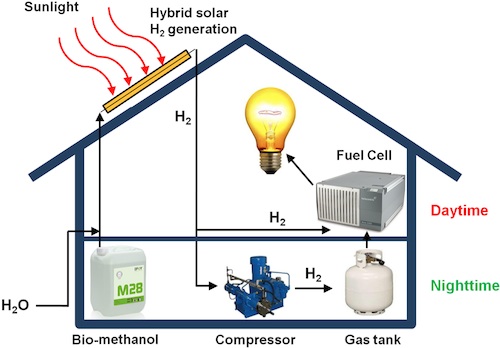Hybrid Solar System for Stationary Electric Power Generation
The main idea of this project is the combination of a solar-powered reformer generating hydrogen from an alcoholic biofuel with a low-temperature fuel cell to achieve a hybrid solar system for stationary electric power generation for single residential or non-residential buildings.
The main goal of this project is to combine both technologies (low-temperature fuel cells and solar power) to achieve synergies in terms of cost and energetic efficiency compared to systems based on a single energy source and energy conversion technology. Direct solar-to-electric energy conversion, such as photovoltaics, is currently not economically competitive with traditional electric power generation. Fuel cell technology using alcoholic fuel possibly generated from biomass (e.g. methanol) is not competitive in terms of costs either. The system proposed for this project consists of relatively cheap, commercially available hardware components (intermediate-temperature solar collector, pressurized gas tank, hydrogen-fed Proton Exchange Membrane (PEM) fuel cell) and benefits in terms of energetic efficiency from the cost-free supply of solar heat. The storage of liquid methanol as primary fuel in simple and safe tank requires almost 1700 times less space than a gas tank, e.g. for hydrogen at standard conditions.
Additionally, the hybrid system with hydrogen as intermediate product benefits from the efficient short-term storage of a limited amount of hydrogen in a pressurized tank. This allows for the temporary storage of energy in the system avoiding the need for expensive and inefficient electric energy storage, e.g. using batteries. For electric power costumers and electric grid companies this leads to the significant advantage of a more controllable and highly flexible demand response since the stored hydrogen can be almost instantaneously converted to electric power by the fuel cell. This system configuration solves the problem of unbalanced power supply by sunlight during day and night, an intrinsic disadvantage of solar power. The proposed system can be operated without relying on power supply from the electric grid during peak hours in the early evening, as it is typical for residential buildings, when the power demand is high, but incoming solar power is already low.
This project will be funded by the California Energy Commission through the EISG Program 2011-2012.
